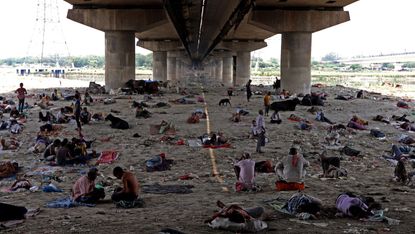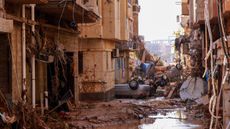How India’s heatwave is pushing the limits of human endurance
Dozens are thought to have died, schools have been forced to close and taps have run dry

“India has been in the grip of what seems like an eternity of heatwaves,” said The Hindu (Chennai). The punishment started in March; then followed the hottest April in 122 years in central and northwest India. Since then, temperatures in some Indian cities have regularly exceeded 45C, while parts of Pakistan have recorded highs in excess of 47C.
Dozens of people are thought to have died, schools have been forced to close, and taps have run dry. In late April, a landfill site in New Delhi spontaneously combusted, sending noxious fumes into the sky. Surging demand for electricity to run air conditioning systems has led to power outages lasting up to eight hours a day; crops have been scorched. And to compound the misery, “there is little respite expected” in the worst-hit areas until June, when monsoon rains should finally arrive.
“Heatwaves are common at this time of year,” said Sandhya Ramesh in The Print (New Delhi). May and June are India’s hottest months. But conditions have been uniquely harsh this year, thanks to a “heat dome” over south Asia – a lingering area of high pressure that traps warm air beneath it like a lid on a pan.
Subscribe to The Week
Escape your echo chamber. Get the facts behind the news, plus analysis from multiple perspectives.

Sign up for The Week's Free Newsletters
From our morning news briefing to a weekly Good News Newsletter, get the best of The Week delivered directly to your inbox.
From our morning news briefing to a weekly Good News Newsletter, get the best of The Week delivered directly to your inbox.
In drier areas, surface (as opposed to air) temperatures have exceeded 60C, contributing to a sharp uptick in forest fires. But in humid areas, conditions have become nearly impossible for humans to endure, said The Statesman (Kolkata). Public health officials talk about “wet bulb” temperatures – measured by wrapping a thermometer in a wet cloth. These give a rough idea of how the human body will cope. In dry heat, evaporation lowers the temperature. But in high humidity, the water can’t evaporate, so there is no cooling effect.
On 1 May, the wet bulb temperature in Chennai, in India’s southeast, hit 31C, making physical activity dangerous. If it were to reach 35C, our bodies would not be able to cope. Even the fittest people would die in about six hours.
Clearly, we can no longer bat away the brutal realities of climate change, said Pratap Bhanu Mehta in The Indian Express (Noida). In 2019, The Lancet estimated 356,000 people died due to excess heat globally. With temperatures soaring, that figure will only go up.
Many Indian cities now have “heat action plans”, said The Economist. Work shifts are changed to keep people out of the sun; extra medical centres are opened; roofs are painted with reflective paint. But there’s only so much that can be done. Unless carbon emissions are reduced, “heatwaves will keep getting more severe and harder to adapt to”.
Sign up for Today's Best Articles in your inbox
A free daily email with the biggest news stories of the day – and the best features from TheWeek.com
Create an account with the same email registered to your subscription to unlock access.
-
 Who actually needs life insurance?
Who actually needs life insurance?The Explainer If you have kids or are worried about passing on debt, the added security may be worth it
By Becca Stanek, The Week US Published
-
 Sexual wellness trends to know, from products and therapies to retreats and hotels
Sexual wellness trends to know, from products and therapies to retreats and hotelsThe Week Recommends Talking about pleasure and sexual health is becoming less taboo
By Theara Coleman, The Week US Published
-
 Is the AI bubble deflating?
Is the AI bubble deflating?Today's Big Question Growing skepticism and high costs prompt reconsideration
By Joel Mathis, The Week US Published
-
 The growing thirst for camel milk
The growing thirst for camel milkUnder the radar Climate change and health-conscious consumers are pushing demand for nutrient-rich product – and the growth of industrialised farming
By Harriet Marsden, The Week UK Published
-
 Why curbing methane emissions is tricky in fight against climate change
Why curbing methane emissions is tricky in fight against climate changeThe Explainer Tackling the second most significant contributor to global warming could have an immediate impact
By Richard Windsor, The Week UK Published
-
 India's controversial plans for untouched Nicobar Isles
India's controversial plans for untouched Nicobar IslesUnder the radar Experts say $9bn development will threaten the existence of remote island's nomadic inhabitants
By Richard Windsor, The Week UK Published
-
 Can the world really wean itself off coal?
Can the world really wean itself off coal?Today's Big Question 'Record' global consumption is set to fall soon but growing demand in China and India could increase tensions
By Harriet Marsden, The Week UK Published
-
 What can Cop28 really achieve?
What can Cop28 really achieve?Today's Big Question Climate summit in UAE proves controversial as UN warns world is falling short of global warming targets
By The Week UK Published
-
 The drying Amazon rainforest: a drought that affects the world
The drying Amazon rainforest: a drought that affects the worldUnder the radar The Amazon is suffering a drought of historic severity and it’s pushing its inhabitants to their limit
By The Week UK Published
-
 Rosebank oil field: pragmatism over future prospects?
Rosebank oil field: pragmatism over future prospects?Talking Point Green campaigners decry 'morally obscene' opening of new oil fields while trying to cut emissions
By The Week Staff Published
-
 Libya: the 'tsunami' that washed away a city
Libya: the 'tsunami' that washed away a cityTalking Point Climate change may have made the storm more likely, but many blame failures of governance for the scale of the tragedy
By The Week Staff Published